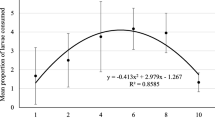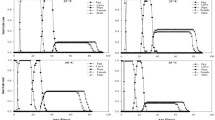Abstract
The Banks grass mite, Oligonychus pratensis (Banks) (Acari: Tetranychidae), is a serious pest of grains, grasses and dates. In order to develop and optimize biological control strategies against the Banks grass mite, the survival and development of the predator, Galendromus flumenis (Chant) (Acari: Phytoseiidae), at eleven constant temperatures between 12 and 44 °C were determined. The survival rates of G. flumenis (67.4–89.5 %) were highest between 26 and 38 °C although it developed successfully from egg to adult at temperatures ranging from 18 to 42 °C. The lower temperature threshold (T 0 ) and thermal constant (K) for total immature development were 13.3 °C and 145.3 degree-days, respectively. The upper temperature threshold was 44.3 °C, and the optimal temperature for development was calculated to be 37.5 °C. These results indicate that G. flumenis is better adapted to high temperatures than most predators in the Phytoseiidae. In addition, the thermal requirements for total development of G. flumenis was found to be very close to those of O. pratensis which indicates that there should be synchrony between the occurrence of the prey and the predator. Therefore, the lack of predation observed in the field is related to other factors, such as the developmental time between O. pratensis and G. flumenis, or the inability of the predator to establish at the same time, and in the same location, as the prey.

Similar content being viewed by others
References
Akaike H (1974) A new look at the statistical model identification. IEEE Trans Autom Control 19:716–723
Briere JF, Pracros P (1998) Comparison of temperature-dependent growth models with the development of Lobesia botrana (Lepidoptera: Tortricidae). Environ Entomol 27:94–101
Briere JF, Pracros P, Le Roux AY, Pierre JSA (1999) A novel rate model of temperature-dependent development for arthropods. Environ Entomol 28:22–29
Broufas GD, Koveos DS (2001) Development, survival and reproduction of Euseius finlandicus (Acari: Phytoseiidae) at different constant temperatures. Exp Appl Acarol 25:441–460
Broufas GD, Pappas ML, Koveos DS (2007) Development, survival, and reproduction of the predatory mite Kampimodromus aberrans (Acari: Phytoseiidae) at different constant temperatures. Environ Entomol 36:657–665
Campbell A, Frazer BD, Gilbert N, Gutierrez AP, Mackauer M (1974) Temperature requirements of some aphids and their parasites. J Appl Ecol 11:431–438
Chant DA (1957) Description of some phytoseiidae mites (Acarina: Phytoseiidae). Part I. Nine new species from British Columbia with key to the species of British Columbia. Part II. Redescription of eight species described by Berlese. Can Entomol 89:289–308
Croft BA, Luh HK (2004) Phytoseiid mites on unsprayed apple trees in Oregon, and other western states (USA): distributions, life-style types and relevance to commercial orchards. Exp Appl Acarol 33:281–326
De Courcy Williams ME, Kravar-Garde L, Fenlon JS, Sunderland KD (2004) Phytoseiid mites in protected crops: the effect of humidity and food availability on egg hatch and adult life span of Iphiseius degenerans, Neoseiulus cucumeris, N. californicus and Phytoseiulus persimilis (Acari: Phytoseiidae). Exp Appl Acarol 32:1–13
Ferrero M, de Moraes GJ, Kreiter S, Tixier M-S, Knapp M (2007) Life tables of the predatory mite Phytoseiulus longipes feeding on Tetranychus evansi at four temperatures (Acari: Phytoseiidae, Tetranychidae). Exp Appl Acarol 41:45–53
Fields PG (1992) The control of stored-products insects and mites with extreme temperatures. J Stored Prod Res 28:89–118
Frazer BD, McGregor RR (1992) Temperature-dependent survival and hatching rate of seven species of Coccinellidae. Can Entomol 124:305–312
Ganjisaffar F, Perring TM (2015) Prey stage preference and functional response of the predatory mite Galendromus flumenis to Oligonychus pratensis. Biol Control 82:40–45
Ganjisaffar F, Fathipour Y, Kamali K (2011) Temperature-dependent development and life table parameters of Typhlodromus bagdasarjani (Phytoseiidae) fed on two-spotted spider mite. Exp Appl Acarol 55:259–272.
Gispert C, Farrar C, Perring TM (2001) Seasonal abundance and the Banks grass mite Oligonychus pratensis (Banks) (Prostigmata: Tetranychidae) and a predatory mite, and their response to sulfur treatment on commercial date palms Phoenix dactylifera L. in Southern California. In: Halladay RB, Walter DE, Proctor HC, Norton RA, Colloff MJ (eds) Proceedings of the 10th international congress of acarology. CSIRO Publishing, Melbourne, pp 403–408
Gotoh T, Yamaguchi K, Mori K (2004) Effect of temperature on life history of the predatory mite Amblyseius (Neoseiulus) californicus (Acari: Phytoseiidae). Exp Appl Acarol 32:15–30
Hagstrum DW, Milliken GA (1991) Modeling differences in insect developmental times between constant and fluctuating temperatures. Ann Entomol Soc Am 84:369–379
Hirschmann W (1962) Gangsystematik der Parasitiformes, Folge 5, Teil 5, Gamasiden. Schrift. Vergl., Milbenkunde, pp 1–56
Huffaker C, Berryman A, Turchin P (1999) Dynamics and regulation of insect populations. In: Huffaker CB, Gutierrez AP (eds) Ecological entomology, 2nd edn. Wiley, New York, pp 269–312
IBM SPSS Statistic (2013) SPSS 22.0 for windows, Chicago
Inc Minitab (2014) MINITAB release 17: statistical software for windows. Minitab Inc, USA
Jeppson LR, Keifer HH, Baker EW (1975) Mites injurious to economic plants. University of California Press, Berkeley
Kouhjani Gorji M, Kamali K, Fathipour Y, Ranjbar Aghdam H (2008) Temperature-dependent development of Phytoseius plumifer (Acari: Phytoseiidae) on Tetranychus urticae (Acari: Tetranychidae). Syst Appl Acarol 13:172–181
Kvalseth TO (1985) Cautionary note about R2. Am Stat 39:279–285
Lactin DJ, Holliday NJ, Johnson DL, Craigen R (1995) Improved rate model of temperature-dependent development by arthropods. Environ Entomol 24:68–75
Lee JH, Ahn JJ (2000) Temperature effects on development, fecundity, and life table parameters of Amblyseius womersleyi (Acari: Phytoseiidae). Environ Entomol 29:265–271
Lee HS, Gillespie DR (2011) Life tables and development of Amblyseius swirskii (Acari: Phytoseiidae) at different temperatures. Exp Appl Acarol 53:17–27
Logan JA, Wolkind DT, Hoty JC, Tanigoshi LK (1976) An analytic model for description of temperature dependent rate phenomena in arthropods. Environ Entomol 5:1133–1140
Margolies DC (1987) Conditions eliciting aerial dispersal behavior in Banks grass mite Oligonychus pratensis (Acari: Tetranychidae). Environ Entomol 16:928–932
Mauk PA, Perring TM, Shea T (2005) Management of banks grass mite in dates. University of California Cooperative Extension, Topics in Subtropics Newsletter 3:1–2
McMurtry JA, Scriven GT (1965) Insectary production of phytoseiid mites. J Econ Entomol 58:282–284
Muma MH (1961) Subfamilies, genera and species of Phytoseiidae (Acarina: Mesostigmata). Bull Florida State Mus Biol Sci 5:267–302
Muma MH (1963) The genus Galendromus Muma, 1961 (Acarina: Phytoseiidae). Fla Entomol 1:15–41
Perring TM, Holtzer TO, Toole JL, Norman JM, Myers GL (1984a) Influence of temperature and humidity on pre-adult development of the Banks grass mite (Acari: Tetranychidae). Environ Entomol 13:338–343
Perring TM, Holtzer TO, Kalisch JA, Norman JM (1984b) Temperature and humidity effects on ovipositional rates, fecundity, and longevity of adult female Banks grass mite (Acari: Tetranychidae). Ann Ent Soc Am 77:581–586
Prasad V (2012) Checklist of the world (Acari: Mesostigmata). Indira Publishing House, West Bloomfield
Prischmann DA, James DG (2003) Phytoseiidae (Acari) on unsprayed vegetation in south central Washington: implications for biological control of spider mites on wine grapes. Int J Acarol 29:279–787
Rodriguez-Saona C, Miller JC (1999) Temperature dependent effects on development, mortality, and growth of Hippodamia convergens (Coleoptera: Coccinellidae). Environ Entomol 28:518–522
Roy M, Brodeur J, Cloutier C (2002) Relationship between temperature and developmental rate of Stethorus punctillum (Coleoptera: Coccinellidae) and its prey Tetranychus mcdanieli (Acari: Tetranychidae). Environ Entomol 31:177–187
Sabelis MW (1985) Capacity for population increase. In: Helle W, Sabelis MW (eds) Spider mites: their biology, natural enemies and control, vol 1B., ElsevierAmsterdam, The Netherlands, pp 35–41
SAS Institute (2012) SAS enterprise guide 5.1. SAS Institute Inc., Cary, North Carolina
Schuster RO, Pritchard AE (1963) Phytoseiid mites of California. Hilgardia 34:191–285
Simpson CB (1903) The codling moth. US Dept Agr Div Entomol Bull 41:1–105
Tixier M-S, Kreiter S, Auger P, Weber M (1998) Colonization of Languedoc vineyards by phytoseiid mites (Acari: Phytoseiidae): influence of wind and crop environment. Exp App Acarol 22:523–542
Tsoukanas VI, Papadopoulos GD, Fantinou AA, Papadoulis GT (2006) Temperature-dependent development and life table of Iphiseius degenerans (Acari: Phytoseiidae). Environ Entomol 35:212–218
Van Dinh N, Sabelis MW, Janssen A (1988) Influence of humidity and water availability on survival of Amblyseius idaeus and A. anonymus (Acarina: Phytoseiidae). Exp Appl Acarol 4:27–40
Vangansbeke D, Audenaert J, Nguyen DT, Verhoeven R, Gobin B, Tirry L, De Clercq P (2015) Diurnal temperature variations affect development of a herbivore arthropod pest and its predators. PLoS ONE 10:1-19
Wainstein BA (1962) Révision du genre Typhlodromus Scheuten, 1857 et systématique de la famile des Phtoseiidae (Berlese, 1916). (Acarina: Parasitiformes). Acarologia 4:5–30
Acknowledgments
We thank Dr. Greg Evans in Systematic Entomology Laboratory of Agricultural Research Service at US Department of Agriculture for predator species identification. We also thank the many contributions of Albert Keck, Oscar Leal, Darcy Reed, Lorena Basta-Pena, and Crystal May. Drs. Subir Ghosh, Timothy Paine, and Erin Rankin provided useful comments on an earlier draft of this manuscript. This research was supported, in part, by the California Date Commission.
Author information
Authors and Affiliations
Corresponding author
Rights and permissions
About this article
Cite this article
Ganjisaffar, F., Perring, T.M. Relationship between temperature and development of Galendromus flumenis (Acari: Phytoseiidae), a predator of Banks grass mite (Acari: Tetranychidae). Exp Appl Acarol 67, 535–546 (2015). https://doi.org/10.1007/s10493-015-9961-9
Received:
Accepted:
Published:
Issue Date:
DOI: https://doi.org/10.1007/s10493-015-9961-9




